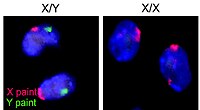
Photo from wikipedia
Simple Summary Biological control programs using natural insect enemies often rely on the production of large numbers of insects for quarantine assessment and release. Many factors can influence the production… Click to show full abstract
Simple Summary Biological control programs using natural insect enemies often rely on the production of large numbers of insects for quarantine assessment and release. Many factors can influence the production of natural enemies, and the production of females is particularly important because females produce offspring. In a series of experiments, we studied the effects of several factors on the production of a parasitic wasp that attacks the eggs of an invasive stinkbug pest of cole crops (i.e., cabbage, broccoli, kale, etc.). The total production of offspring dropped when females were older than 24 days old and was highest when the temperature during oviposition was 26.6 °C. The production of females increased when the eggs were exposed to female wasps for one day rather than two days. The results show that the production of this parasitic wasp can be maximized when eggs are exposed for only one day, when females that are less than 24 days old are used, and at temperatures of around 26 °C. Abstract Manipulating the factors that influence progeny production and sex ratio in parasitoids can help maximize the production of quarantine bioassays and/or mass releases. In a series of experiments, we studied the effects of several factors on offspring production and sex ratio in the parasitoid Gryon aetherium (Hymenoptera: Scelionidae), a candidate biological control agent for Bagrada hilaris (Hemiptera: Pentatomidae). Progeny production was influenced by maternal age and dropped when females were 24 or 28 days old and decreased on the second day of exposure. Overall, the offspring sex ratio was highly variable in G. aetherium and was affected by the duration of exposure, with higher proportions of females emerging after one day of exposure than after two days, but was not affected by female density, female age/host deprivation, or temperature during oviposition. Progeny production was affected by the temperature during oviposition and was highest at 26.6 °C. The results indicate that production of G. aetherium can be maximized at one day of exposure, using females that are less than 24 d old, and at temperatures of around 26 °C.
Journal Title: Insects
Year Published: 2022
Link to full text (if available)
Share on Social Media: Sign Up to like & get
recommendations!